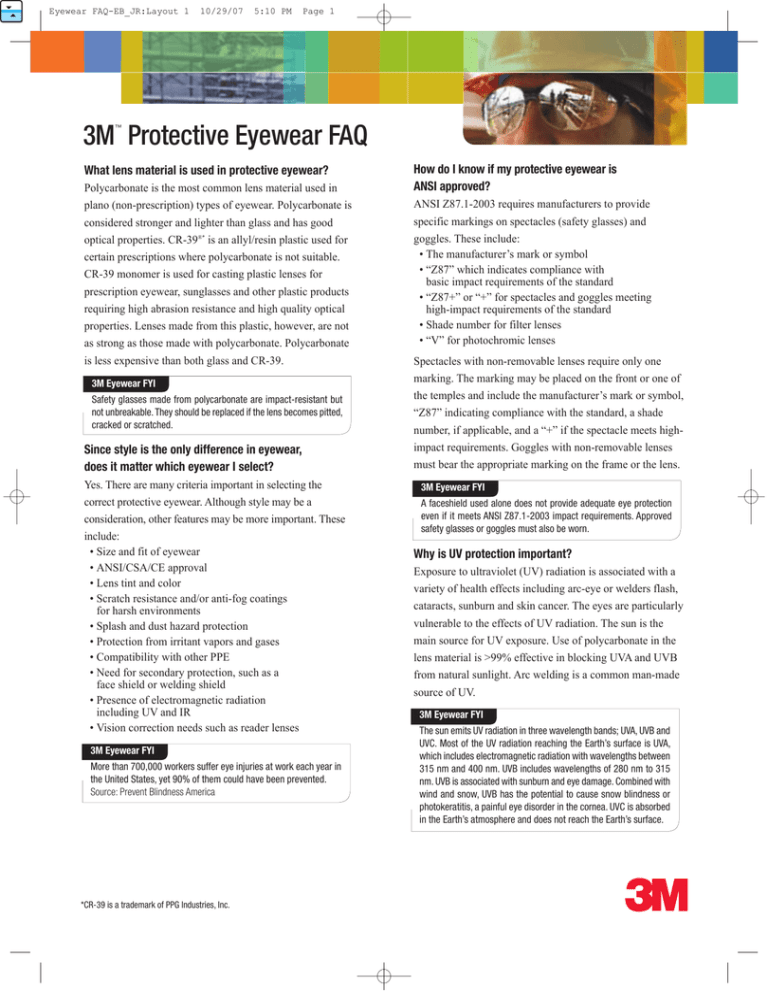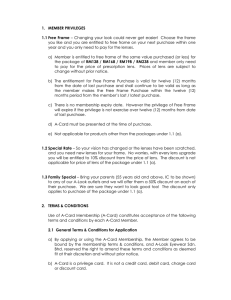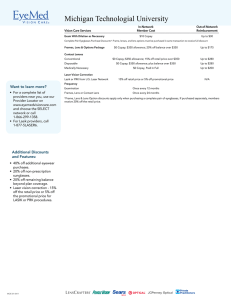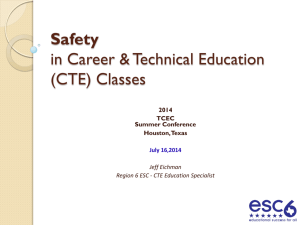
Eyewear FAQ-EB_JR:Layout 1
10/29/07
5:10 PM
Page 1
™
3M Protective Eyewear FAQ
What lens material is used in protective eyewear?
Polycarbonate is the most common lens material used in
plano (non-prescription) types of eyewear. Polycarbonate is
considered stronger and lighter than glass and has good
optical properties. CR-39®* is an allyl/resin plastic used for
certain prescriptions where polycarbonate is not suitable.
CR-39 monomer is used for casting plastic lenses for
prescription eyewear, sunglasses and other plastic products
requiring high abrasion resistance and high quality optical
properties. Lenses made from this plastic, however, are not
as strong as those made with polycarbonate. Polycarbonate
is less expensive than both glass and CR-39.
3M Eyewear FYI
Safety glasses made from polycarbonate are impact-resistant but
not unbreakable. They should be replaced if the lens becomes pitted,
cracked or scratched.
Since style is the only difference in eyewear,
does it matter which eyewear I select?
Yes. There are many criteria important in selecting the
correct protective eyewear. Although style may be a
consideration, other features may be more important. These
include:
• Size and fit of eyewear
• ANSI/CSA/CE approval
• Lens tint and color
• Scratch resistance and/or anti-fog coatings
for harsh environments
• Splash and dust hazard protection
• Protection from irritant vapors and gases
• Compatibility with other PPE
• Need for secondary protection, such as a
face shield or welding shield
• Presence of electromagnetic radiation
including UV and IR
• Vision correction needs such as reader lenses
3M Eyewear FYI
More than 700,000 workers suffer eye injuries at work each year in
the United States, yet 90% of them could have been prevented.
Source: Prevent Blindness America
*CR-39 is a trademark of PPG Industries, Inc.
How do I know if my protective eyewear is
ANSI approved?
ANSI Z87.1-2003 requires manufacturers to provide
specific markings on spectacles (safety glasses) and
goggles. These include:
• The manufacturer’s mark or symbol
• “Z87” which indicates compliance with
basic impact requirements of the standard
• “Z87+” or “+” for spectacles and goggles meeting
high-impact requirements of the standard
• Shade number for filter lenses
• “V” for photochromic lenses
Spectacles with non-removable lenses require only one
marking. The marking may be placed on the front or one of
the temples and include the manufacturer’s mark or symbol,
“Z87” indicating compliance with the standard, a shade
number, if applicable, and a “+” if the spectacle meets highimpact requirements. Goggles with non-removable lenses
must bear the appropriate marking on the frame or the lens.
3M Eyewear FYI
A faceshield used alone does not provide adequate eye protection
even if it meets ANSI Z87.1-2003 impact requirements. Approved
safety glasses or goggles must also be worn.
Why is UV protection important?
Exposure to ultraviolet (UV) radiation is associated with a
variety of health effects including arc-eye or welders flash,
cataracts, sunburn and skin cancer. The eyes are particularly
vulnerable to the effects of UV radiation. The sun is the
main source for UV exposure. Use of polycarbonate in the
lens material is >99% effective in blocking UVA and UVB
from natural sunlight. Arc welding is a common man-made
source of UV.
3M Eyewear FYI
The sun emits UV radiation in three wavelength bands; UVA, UVB and
UVC. Most of the UV radiation reaching the Earth’s surface is UVA,
which includes electromagnetic radiation with wavelengths between
315 nm and 400 nm. UVB includes wavelengths of 280 nm to 315
nm. UVB is associated with sunburn and eye damage. Combined with
wind and snow, UVB has the potential to cause snow blindness or
photokeratitis, a painful eye disorder in the cornea. UVC is absorbed
in the Earth’s atmosphere and does not reach the Earth’s surface.
Eyewear FAQ-EB_JR:Layout 1
10/29/07
5:10 PM
Page 2
Why is lens color an important consideration?
Are my safety glasses resistant to chemicals?
Lenses are offered in different tints and colors for a variety
of reasons, including vision enhancement, glare reduction
and style preference. Lighting conditions in the work
environment and the need for filtering of specific visible
light wavelengths dictate vision enhancement and glare
reduction requirements. Style preference is mostly the
cosmetic appeal that certain lens colors offer. Examples of
lens colors commonly found and specific applications
where they may be used are presented below.
Safety glasses are generally designed for impact protection
from flying particles and should not be used where there is
potential for direct contact with chemicals. Goggles with
splash protection are the only protective eyewear intended
for this use. Splash goggles typically have indirect or
covered vents to minimize liquids and dusts from entering.
Lens Color
Use Application
Clear
Indoor work environments with normal to
low lighting conditions
Amber
Low light applications or other environments
where greater light contrast is required
(e.g. overcast conditions, foggy days, dusk)
Mirrored
Indoor and outdoor under bright conditions,
cosmetic appeal
Smoke
Outdoor under bright sunlight
What does the term “base curve” mean?
Base curve is used to describe the curvature of the front
surface of the eyewear lens. Low base curve eyewear, <6
base spherical, have less curvature on the outer surface.
Side protection is commonly supplemented on these models
through the use of side shield extensions. High base curve
eyewear >6 base spherical, have more curvature on the
outer surface. Lens curvature allows side protection through
wrap-around design.
Is fit important?
Yes. Individual facial features, comfort needs and
compatibility with other PPE all affect eyewear fit. Eyewear
size, adjustability (e.g. nose height, temple length and
angle, etc.), and comfort supports are all desirable features.
3M Eyewear FYI
The NIOSH publication Eye Protection for Infection Control offers
eyewear selection guidelines for workers at risk of acquiring
infectious diseases via ocular exposure. An appropriately fitted,
indirectly vented goggle with anti-fog coating provides the most
reliable eye protection from splashes, sprays and respiratory droplets.
3
Occupational Health
and Environmental Safety Division
3M Center, Building 0235-02-W-70
St. Paul, MN 55144-1000
U.S.A.
Sales: 1-800-328-1667
Technical Assistance: 1-800-243-4630
Web site address: 3M.com/OccSafety
Please recycle. Printed in U.S.A.
© 3M 2007. All rights reserved.
70-0714-8789-9
What type of coatings are available on
protective eyewear?
Coatings are applied to lenses to enhance eyewear
performance. They are designed to improve scratch
resistance, minimize fogging and provide anti-static
properties. No eyeglass lens material is scratch-proof.
However, a lens treated on the front and back with a clear,
hard coating does improve scratch resistance. Polycarbonate
lenses, which offer great impact strength, are easily
scratched. Softness properties of polycarbonate typically
require that a scratch-resistant coating be applied to
improve their durability. Other coatings, such as anti-fog,
are applied to the lens to improve performance in harsh
environments. Anti-fog coatings may be either hydrophyllic
(water loving) or hydrophobic (repel water) types. Anti-fog
coatings are generally not permanent and will erode after
repeated cleanings. Proper care and cleaning of an anti-fog
lens, following the manufacturer’s recommendations, will
help maintain coating performance.
3M Eyewear FYI
Certain OSHA regulations, which address eye and face protection,
such as 29 CFR 1910.133, specifically reference compliance with
Z87.1-1989. While OSHA has not yet adopted provisions of Z87.12003, the agency typically allows newer ANSI standards that are at
least as protective as those referenced in its standard to be followed
without issuance of citations.
Where can I find more information on protective
eyewear and safety?
3M Occupational Health and Environmental Safety Division
www.3M.com/OccSafety
OSHA, Occupational Safety & Health Administration
www.osha.gov
NIOSH, National Institute for Occupational Safety and Health
www.cdc.gov/niosh
CDC, Centers for Disease Control
www.cdc.gov
Prevent Blindness America
www.preventblindness.org
ANSI, American National Standards Institute
www.ansi.org






